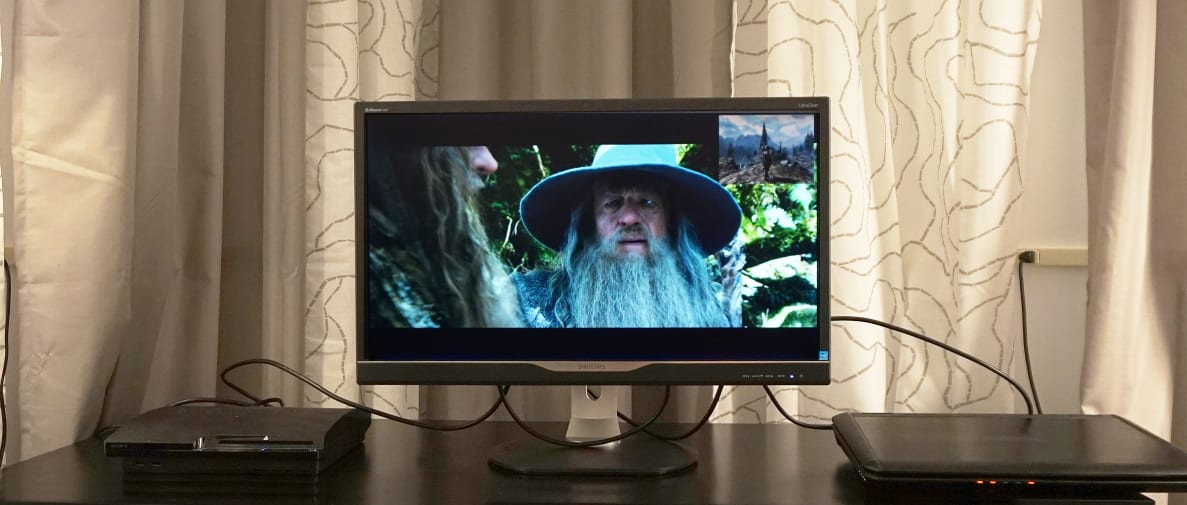The 288P6 wields a minimalist design, TN (Twisted Nematic) panel, built-in USB ports, and "Multi view" (picture-in-picture/picture-by-picture) options. It boasts a standard 5ms G2G response time and pivots easily between landscape and portrait modes. This sort of generalist approach is par-for-the-course within the current 4K monitor landscape, with Philips looking to snag as much of the UHD pie as possible.
Unfortunately, the price is just way too high for a "general" approach. While the 288P6 is fine—and can now be found for around $650 at retail—we've seen cheaper 28-inch 4K displays that better cater to both general and niche buyers in this part of the market.
If you want good port selection, a great stand, and performance that just scrapes by for the sake of almighty 4K, this one won't let you down, but those with specific needs or looking for the best value may need to look elsewhere.
Design & Features
A general approach that yields so-so appeal
You can tell a lot about a monitor by its physical features. This is the case with the 288P6, with its generous stand flexibility and a lax approach to design filigree. It emphasizes neither a hard professional focus (via accessories like a shading hood, or tactile push buttons) nor a niche focus on gaming like the Asus PB287Q.
While single-purpose users may not like this approach, those with a home office that occasionally becomes a gaming room might enjoy the flexibility. It otherwise doesn't exactly stand out in terms of design, but it's nice enough to look at.
A flat pedestal base supports an angular, flexible neck, holding the 28-inch screen about five inches from the desktop. Semi-thin matte bezels wrap the top and sides of the screen—the lower bezel is larger, to give room for the display's touch-sensitive buttons and a silver strip emblazoned with the Philips logo.
The panel isn't particularly thin, but is slim enough while leaving room for more practical additions. This yields this monitor's best inclusion: a full USB hub on the right side with four inputs, one of which is a "fast-charge" for devices like a tablet or smartphone.
You'll find video/audio connection ports on the underside of the display, including PC audio input, a headphone jack, VGA input, DisplayPort 1.2 input, HDMI input, and a DVI input. Including a VGA (RGB) input on a huge 4K monitor like this is puzzling—a second HDMI inputs would be much more useful—but we imagine someone, somewhere will need it.
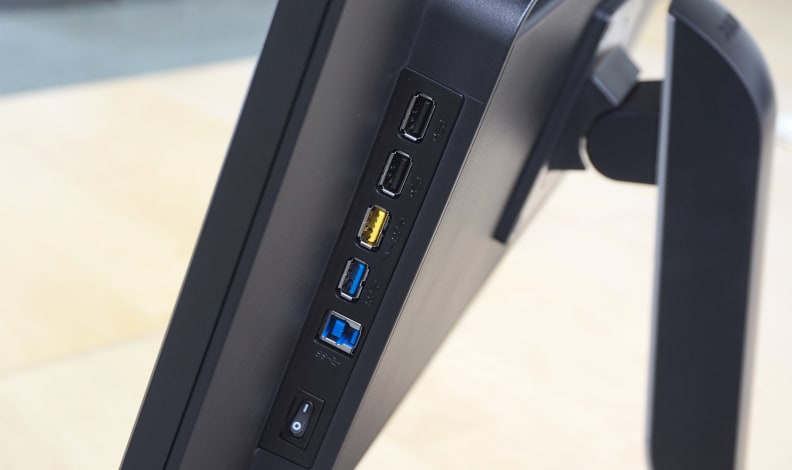
On the right side, you'll find a full USB hub with four USB inputs, one of which is a "fast charge" USB 3.0 option.
The stand's flexibility is definitely this monitor's best physical trait. The panel can raise/lower by about 5 inches, tilt forward/backward by ±20°, and pivot side to side easily on its base. Movements are fluid and firm, the way they should be.
{{ photo_gallery "design" }}
The monitor's menu software can be a little finicky thanks to the touchscreen buttons, but navigating the various features gets easier with a bit of practice. There are five hotkeys: one for picture mode selection, one for input selection, one for picture-in-picture/picture-by-picture selection, and one for power. The buttons double as navigation when you're in a menu.
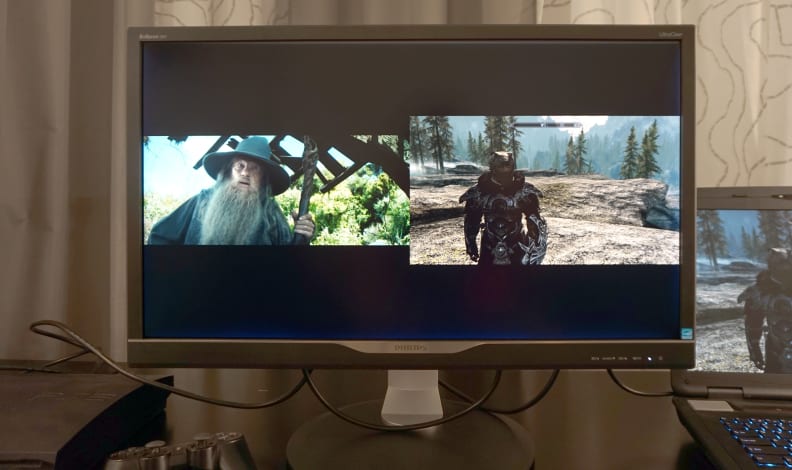
With the 288P6's picture-by-picture mode, you can finally play a high-fantasy RPG while you watch a high-fantasy film.
It's always nice to have a 4K monitor that's capable of multi-view modes such as PiP functionality, but it's yet another reason we'd prefer to have at least two HDMI inputs. While splitting between DisplayPort and HDMI is probably what most people will go for, what if your laptop only has HDMI out, and you want to plug in another HDMI source, like a game console? You're kind of out of luck here.
{{ photo_gallery "software" }}
All said, the 288P6 is well-rounded enough, but could stand to lean a little more towards serious users at this price point. The "catch-all" approach to inputs would make sense if this were a general 1080p monitor, but at $650 and up, this is the kind of display you invest in with full knowledge of what you want out of it—the exact opposite of how most casual users shop.
Specs & Performance
The whole is equal to the sum of the parts, but the parts are sub-par.
The 288P6 offers consumers a decent design and a few useful features, but if you're looking for a high-end 4K monitor, this Philips is not it.
The drawback here is the panel type, which is TN or Twisted Nematic. Typically, TN panels offer fast refresh rates, but poorer color fidelity than IPS panels, worse black levels than VA panels, and typically narrow viewing angles compared to either.
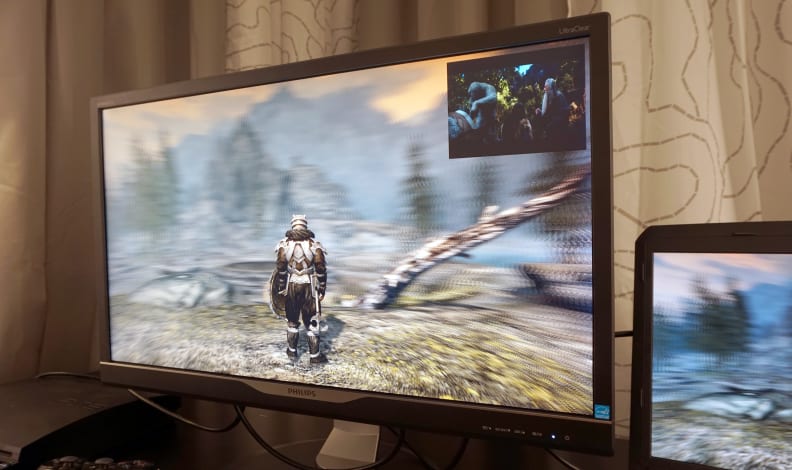
The 288P6 wields a TN (Twisted Nematic) panel, which boasts decent color accuracy but lacks the vivacity and "pop" of an IPS panel.
Naturally, if you're desperate for a semi-affordable 4K monitor, you're going to have to settle for TN at the moment, but it might more sense to simply wait for higher-quality 4K options to become affordable.
Testing revealed acceptable (but flawed) sRGB color accuracy, a middling contrast ratio, poor off-angle viewing, and dodgy backlight uniformity; we're not sure 4K resolution is worth all that, frankly. You can see the data on the Science Page.

During testing, the 288P6 struggled to produce a smooth gamma curve, which made for some of the black crush (missing shadow details) you can see here.
This isn't the first 4K monitor to wield a TN panel—the Asus PB287Q is almost a carbon-copy of the 288P6, but actually performs a little better and for less money. This Philips may boast the top-tier resolution desired by gamers and photo editors, but the Asus is faster, and its semi-skewed sRGB (digital) color lacks the reach required by print designers.
The Verdict
Suffering from an identity crisis
As a 28-inch 4K monitor for $799, the 288P6 sounds pretty fancy on paper... but compared to the market in 2015 it just doesn't hold up. It's clear that 4K displays are here to stay, and as such should be taken as seriously for purchase as any Full HD option.
Unfortunately the 288P6 is still parading as an early adopter's product—at an early adopter price point—but lacks the specificity to justify that expense. We're already at a point where a 4K monitor needs to give buyers more than just high resolution, and unfortunately, the 288P6 doesn't.
Yes, it has a nice physical design, good features like picture-in-picture and plenty of display inputs. But so do several other 4K monitors on the market, including this Asus, which is cheaper ($579.99 at retail) and has better all-around performance. USB ports are a great inclusion, but not for the price difference.
Ultimately, it seemed like Philips couldn't make up its mind whether it wanted this monitor to be good for casual use, business users, or gamers. By ultimately settling on "all of them," Philips actually wound up serving nobody well, relying on the 4K resolution to justify the price.
With similar, cheaper monitors already on the market and larger 4K TVs routinely selling for under $1,000, this Philips just seems late to the party. A semi-affordable, kinda-large 4K monitor at this price might've worked 12 or 18 months ago when 4K was a rare commodity. But in 2015? Not so much. The Philips 288P6 (MSRP $799.99) is an average performer that features 4K (3,840 x 2,160) resolution and a few 4K-facing features. In this regard, it fails to stand out from the crowd, and the price is a little too high for many of the performance drawbacks associated with TN (Twisted Nematic) panel types.
Essentially, all of the monitor's strengths are specs you can find online: the resolution, the port selection/USB hub, and the flexible stand. Color fidelity, contrast, and viewing angle range from standard to sub-par, which basically means you're paying a lot for more pixels.
Color Gamut
Color ability is where TN type panels tend to fall short, and the 288P6 is not an exception. Naturally, most users won't notice a bit of over-saturation in greens or under-saturation in reds, but these flaws do mean you'd have to tweak and calibrate the display for it to work out for digital photo editing or design work. The color here is good enough for general tasks, but considering the quality, it's one reason we feel that the price is too high. Unfortunately, the limited color mapping is not a great choice if you're looking for a future-proof option, either, as expanded color is the next big step forward for Ultra High Definition.
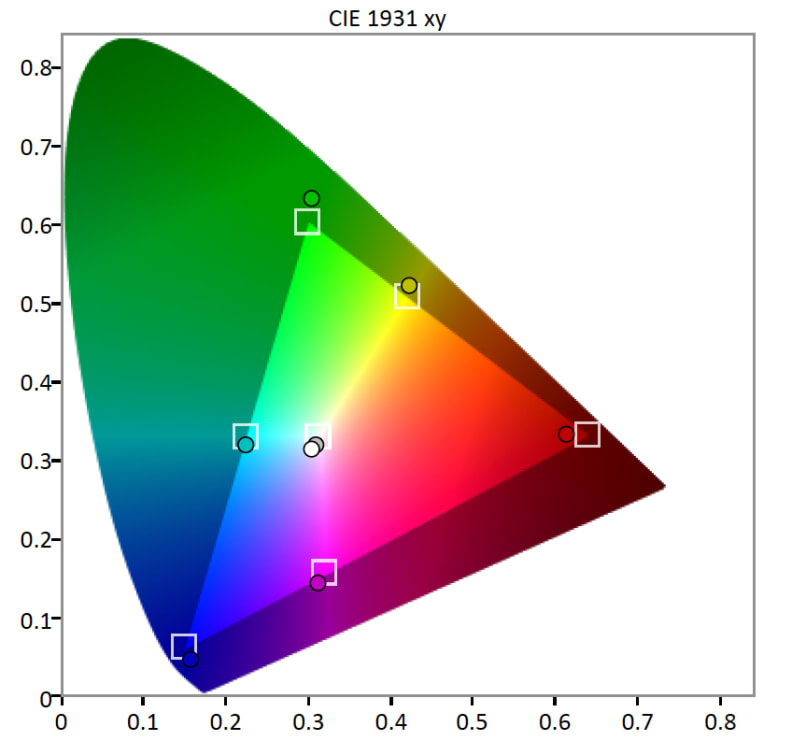
The 288P6's over-saturated green point and under-saturated red point are par for the course in a TN (Twisted Nematic) display.
Grayscale Error
Grayscale error refers to visible deviations in neutral grayscale elements (some black, grays, whites) from the D65/sRGB white point standard. For general use like web browsing or watching YouTube videos, a bit of grayscale error isn't going to matter much, but any professional monitor used by colorists or designers should ideally be within a certain range of accuracy. Grayscale error is expressed in a collective called DeltaE, where a DeltaE of 3 or less is considered ideal.
The Philips 288P6 tested with a grayscale DeltaE of 8, which isn't terrible, but also means perceptibly imperfect neutral elements. Again, this isn't going to negatively impact general tasks, but considering the relative scarcity of native 4K content, we doubt most users interested in this display have general tasks in mind.
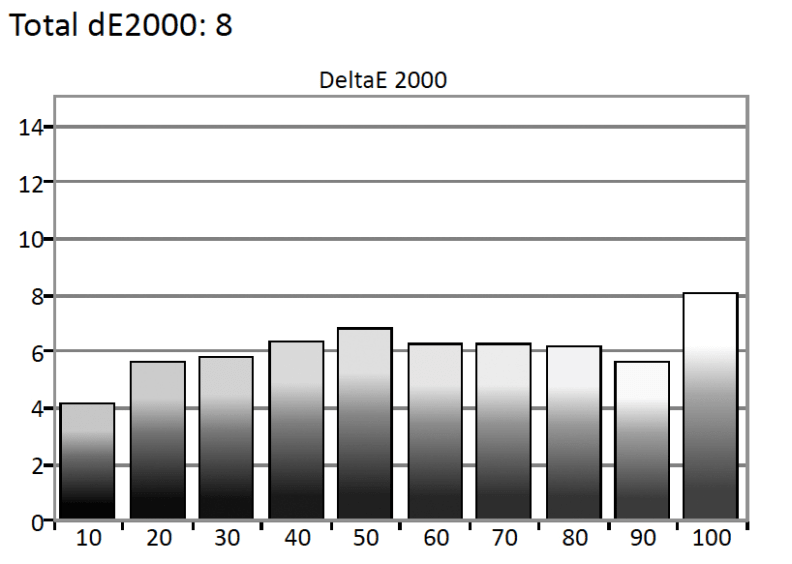
The 288P6 tested with a grayscale DeltaE of 8, which means its neutral elements (gray, white tones) show some perceptible deviation from the sRGB white point standard.
RGB Balance
A display's RGB balance (or color filter emphasis) is often the reason behind both its perceptible grayscale error and, sometimes, discrepancies in color saturation. This test measures the relative emphasis of the red, green, and blue sub-pixels (or color filters) relative to one another. Ideally, each sub-pixel will be emphasized by 100%—not too much, not too little.
Testing revealed that the 288P6 tends to mildly over-emphasize the blue sub-pixel while (in turn) mildly under-emphasizing the red sub-pixel and clipping green (which carries luminance) around 90 IRE, which (as we'll see) has lots to do with the display's gamma performance, too. The undersaturated red in the gamut has a bit to do with this under-emphasis, and the errors in emphasis are also the cause of the monitor's aforementioned grayscale error.
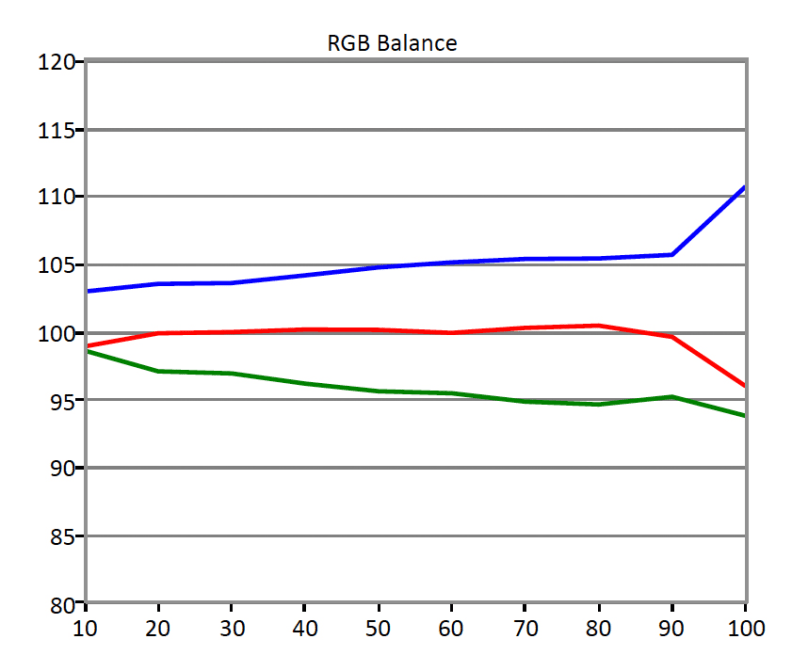
The 288P6 tends to over-emphasize blue at the expense of green and red, which causes multiple issues with its performance.
Gamma Curve
A display's gamma curve is a digital correction that forces it to allocate light (or luminance) in an analog, non-linear fashion for human eyes. As displays grow brighter, they must add logarithmically more light at higher steps in order for humans to notice the difference. Likewise, a gamma curve ensures that shadow detail and black levels are properly preserved by adding small steps as the display ascends the signal input out of black.
This is one area where the 288P6 struggled notably. We measured a gamma sum of 2.84, with very poor shadow detail resulting in "black crush" and aggressive mid-high luminance allocation resulting in notable clipping around 90 IRE, or towards the top of the signal input spectrum. This result is a bit hard to quantify, as most monitors have no issue following a standard gamma curve. On the other hand, the clipping observed during the RGB balance test may have something to do with this Philips' inability to follow a smooth gamma curve.
This is, again, not something that looks horrible for casual use, but rules out this monitor as a candidate for more serious tasks like photo/video editing.
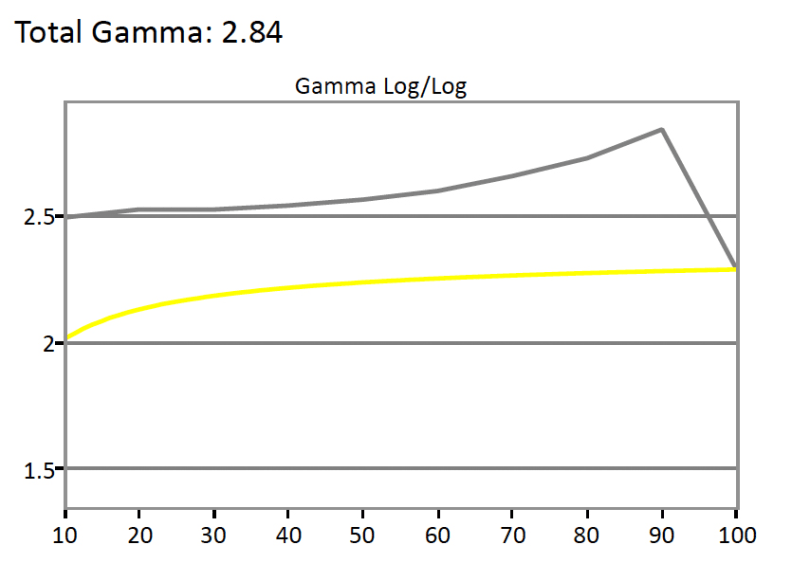
The 288P6 tested with a gamma curve of 2.84—it adds luminance too slowly out of black and ramps up into highlights a little too suddenly.
Meet the tester
Lee was Reviewed's point person for most television and home theater products from 2012 until early 2022. Lee received Level II certification in TV calibration from the Imaging Science Foundation in 2013. As Editor of the Home Theater vertical, Lee oversaw reviews of TVs, monitors, soundbars, and Bluetooth speakers. He also reviewed headphones, and has a background in music performance.
Checking our work.
Our team is here for one purpose: to help you buy the best stuff and love what you own. Our writers, editors, and lab technicians obsess over the products we cover to make sure you're confident and satisfied. Have a different opinion about something we recommend? Email us and we'll compare notes.
Shoot us an email
